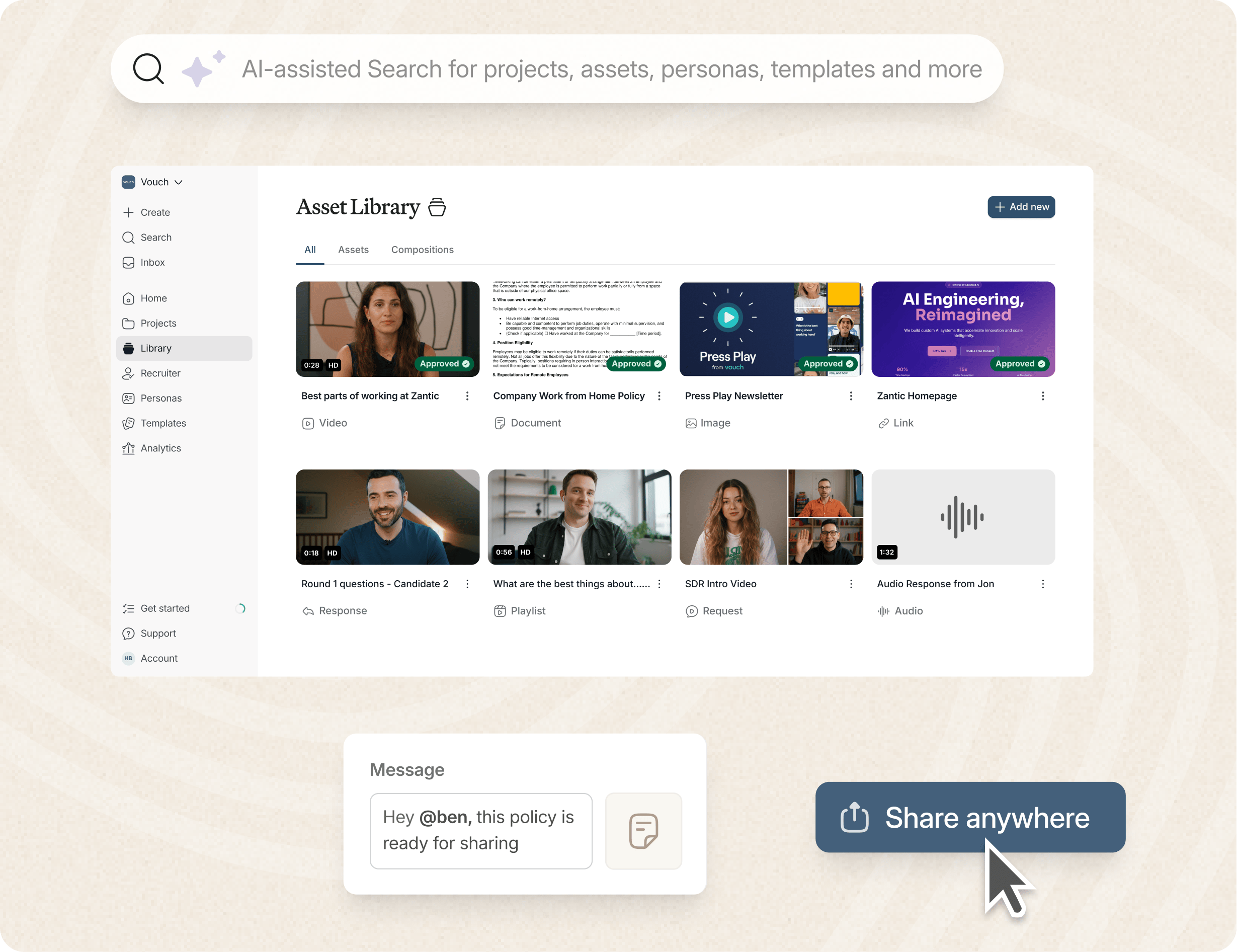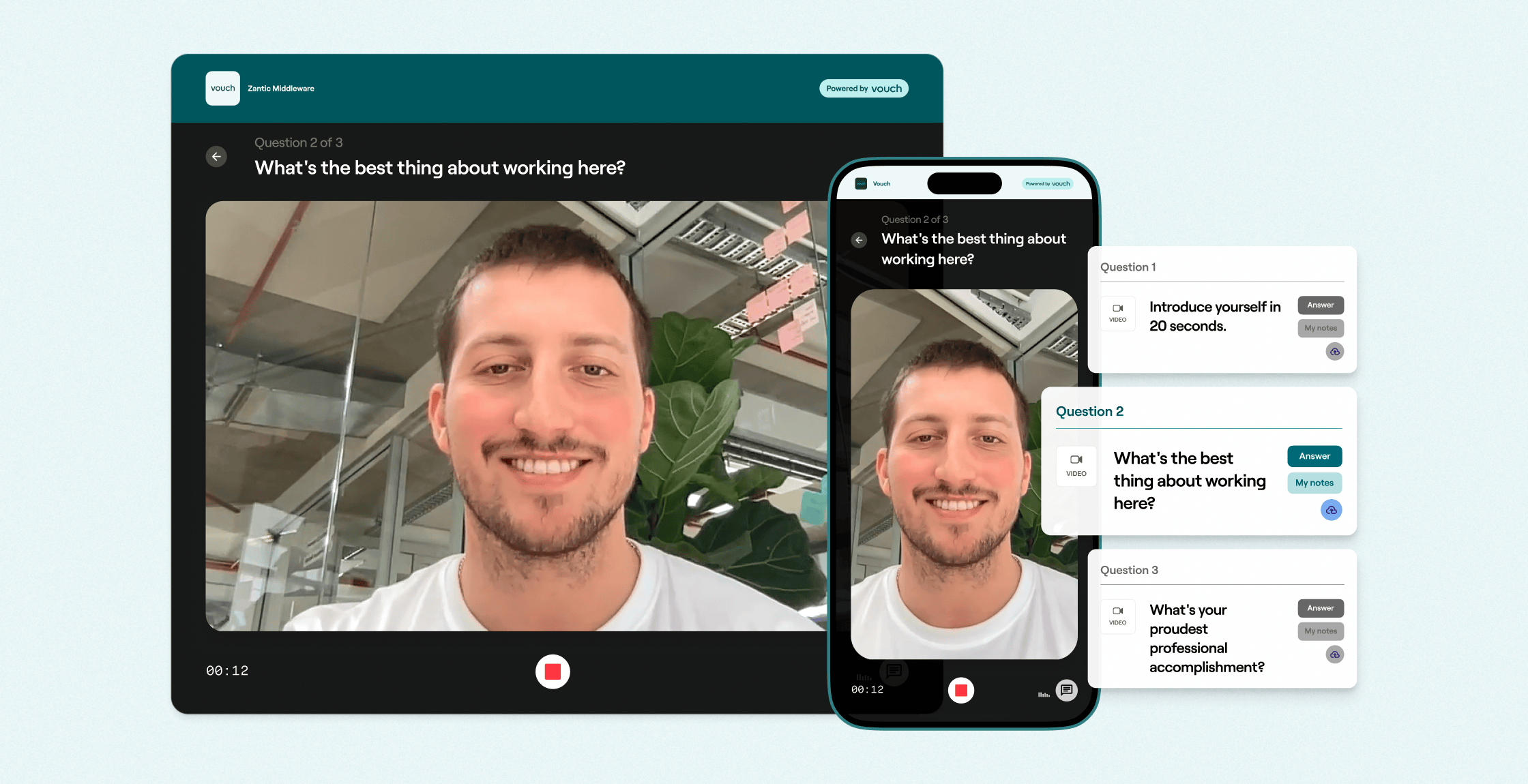One benefit of internal storytelling is inspiring employees by helping them imagine the future of your company, and how they play a pivotal role in it while achieving their own dreams and goals.
The ability to tell stories and influence people is nothing new; all of the great (and not-so-great) leaders throughout history have been great storytellers. Perhaps you've met a really good politician, sales or marketing person in real life and had a chat with them? One thing you'll quickly pick up on is their remarkable ability to draw you in with engaging stories.
Internal storytelling in business takes this same approach, and it plays a crucial role in driving employee motivation and investment through the power of story.
Key Takeaways:
- Internal storytelling is an effective tool for boosting employee engagement.
- Improved productivity and job satisfaction are key benefits of internal storytelling.
- Tools like Vouch video make internal storytelling easier and much more powerful.
What Is The Historical Significance of Storytelling?
Storytelling has been an integral part of our human culture since ancient times and has been the foundation of education for thousands of years. Historically, storytelling was used for communication, education, entertainment, connection, inspiration, fostering unity, and conveying vision, mission, and values.
That's a lot to roll off the tongue, but in essence, storytelling has the power to inspire and drive meaningful action; from writing on stones and public speeches to Instagram posts, the power of storytelling hasn't changed.
What Is Internal Storytelling in the Corporate Context?
In the corporate context, internal storytelling refers to the strategic use of narratives to communicate company culture, values, and objectives to employees. It goes beyond the mere conveyance of facts and figures; internal storytelling is about creating an emotional connection and inspiring action among employees.
By using narratives that resonate with employees on a personal level, internal storytelling helps to foster a sense of unity, purpose, and belonging within your organization. It allows employees to see themselves as part of a larger story, contributing to something meaningful and impactful.
Through internal storytelling, organizations can effectively convey their vision, mission, and core values. It helps employees understand the 'why' behind their work, and how their individual efforts contribute to the overall success of the organization.
What is The Emotional Impact of Storytelling on Employees?
Internal storytelling can move your employees, evoke emotions, and create a deep sense of connection. When employees are engaged in a well-crafted story, they become more emotionally invested in its message.
A good story is also "sticky", and as a result, employees feel a stronger sense of purpose, loyalty, and commitment to their work and mission. It really is that powerful when done right.
The AI-enabled workspace for talent teams.
- Unified workspace for talent teams
- Accelerate hiring with AI tools
- Auto-generate polished hiring and employer brand content
- Easily repurpose assets across all channel

Statistics vs. Storytelling, How To Use Them?
Today, it feels like everything is driven by statistics and data because it kind of is. Almost every decision made in a business today is made from data, and that is completely logical and helps mitigate risks.
But data doesn't create a personal and emotional connection with employees. Even the most data-driven people will use data to make decisions, but this is usually secondary to gut and emotion when it comes to believing in something wholeheartedly.
Of course, data and analytics can and should be used in storytelling, but storytelling is designed to tap into the power of emotions to make information more memorable and impactful.
By sharing stories that resonate with your employee's values and experiences, employees feel a deeper connection to the organization and are more likely to be motivated and engaged in their work.
Should You Use Storytelling With a Remote Workforce?
Absolutely! Internal storytelling has a wide-reaching impact and can help you build a unified workforce across any geographical boundary. In today's global world, many companies have employees spread across different locations, making it essential to establish a sense of unity and cohesion - exactly where storytelling comes in.
Through internal storytelling, organizations can create a shared understanding of company culture, values, and objectives among employees regardless of their physical location. Stories have the power to break down geographical barriers by bridging the gap between employees, fostering a sense of belonging, and promoting collaboration.
When employees feel connected to the larger organizational narrative, they are more likely to align their actions with the company's goals and work together towards a common purpose.
Using Storytelling To Break Down Silos
In addition to building a unified workforce, internal storytelling can also enhance knowledge transfer and break down silos within organizations. Silos are barriers that prevent effective communication and collaboration between different teams or departments, hindering productivity and innovation.
By encouraging the sharing of stories and experiences, organizations can break down these silos and promote a culture of collaboration and information sharing.
Through storytelling, employees gain valuable insights into the work being done in other areas of the organization, fostering cross-functional understanding and encouraging the sharing of expertise.
Moreover, storytelling creates an environment where employees feel comfortable sharing their ideas and perspectives, irrespective of their hierarchical positions. It provides a platform for diverse voices to be heard, contributing to a more inclusive and innovative workplace culture. When employees feel valued and heard, they are more likely to engage actively in their work and contribute to the overall success of the organization.
The Hero's Journey and Its Application in Business
Effective storytelling requires both art and strategy. One storytelling framework that has been widely used in various industries is the Hero's Journey. The Hero's Journey is a narrative structure that involves three fundamental parts: departure, initiation, and return. This framework, popularized by Joseph Campbell, outlines the hero's transformational journey from the ordinary world to the extraordinary world and back.
In the context of business, the Hero's Journey can be applied to narratives that involve the growth and development of individuals or organizations. It provides a compelling structure for conveying challenges, victories, and lessons learned. By presenting a relatable and inspiring journey, business stories can capture the attention and engage the emotions of the audience.
A hero's journey is always best told through videos like Vouch, companies like Canva, Amazon, HubSpot, Cisco, Nike, and more use our video platform to share their internal stories.
How Do You Create A Powerful Story To Tell?
While the Hero's Journey provides a narrative framework, it is essential to optimize stories for maximum engagement and impact. One approach is to follow the SUCCES framework, which stands for Simple, Unexpected, Concrete, Credible, and Emotional Stories.
- Simple: Stories should be clear, concise, and easy to understand. They should have a central theme or message that is easily grasped by the audience.
- Unexpected: Stories that have unexpected twists or surprises grab attention and create intrigue. They keep the audience hooked and eager to know what happens next.
- Concrete: Concrete stories use vivid details, sensory language, and specific examples to make the narrative more relatable and tangible for the audience. This makes the story more memorable and impactful.
- Credible: Credible stories are based on real experiences, data, or evidence. They establish trust and credibility with the audience, making the story more persuasive and believable.
- Emotional: Emotional stories tap into the audience's feelings, creating a deeper connection and resonance. They evoke empathy, inspire action, and make the story more memorable.
By crafting stories based on the SUCCES framework, businesses can create narratives that captivate and influence their employees.
How Do Modern Companies Use Internal Storytelling?
In 2025's quickly evolving economy and landscape, organizations are embracing modern approaches to internal storytelling. These innovative storytelling techniques utilize:
- Interactive Digital Platforms: Companies are leveraging digital tools and platforms like Vouch video to create interactive storytelling experiences and employer brand videos. Through videos, podcasts, and interactive websites, employees can engage with the company's narrative and immerse themselves in the story.
- Transmedia Storytelling: This approach involves creating a story that extends across multiple media platforms, such as social media, blogs, and videos. By utilizing different channels, organizations can reach employees through various touchpoints, ensuring a consistent and immersive storytelling experience.
- User-Generated Content: Businesses are encouraging employees to contribute their own stories and experiences to the company narrative. By showcasing employee perspectives and voices, organizations can foster a sense of belonging and empower individuals to be part of the storytelling process.
These three modern approaches to internal storytelling are reshaping the way organizations communicate and engage with their employees. By embracing innovative techniques, businesses can create a captivating narrative that resonates with employees on a deeper level, fostering a stronger connection to the company's values and objectives.
FAQs
What is one benefit of internal storytelling for employee engagement?
Internal storytelling creates an emotional connection that leads to increased motivation, commitment, and job satisfaction among employees, for internal and remote employees alike!
How is internal storytelling defined in the corporate context?
Internal storytelling in the corporate context refers to the strategic use of narratives to effectively communicate company culture, values, and objectives to employees.
What is the impact of storytelling on employees?
Storytelling evokes emotions and creates a sense of connection, fostering employee engagement and a sense of pride and ownership in their work.
How does storytelling create an emotional connection compared to statistics and data?
Unlike statistics and data, storytelling creates a personal and emotional connection with employees, making the information more memorable and impactful.
What is the wide-reaching impact of internal storytelling in organizations?
Internal storytelling builds a unified workforce across geographical boundaries, enhances knowledge transfer, and breaks down silos by promoting collaboration and information sharing.
How can the art and strategy behind effective storytelling impact businesses?
The art and strategy behind effective storytelling, such as applying the Hero's Journey and utilizing the SUCCES framework, create lasting impact and engagement with the audience.
What are some modern approaches to internal storytelling in business?
Businesses employ innovative storytelling techniques to effectively communicate their message and engage employees, fostering a sense of unity and purpose.
How can organizations integrate internal storytelling into their corporate culture?
Integrating internal storytelling into the corporate culture is essential for long-term success and employee engagement, creating a shared understanding and sense of belonging.
How can organizations measure the success and ROI of storytelling initiatives?
Organizations should have metrics in place to measure the success and return on investment (ROI) of their storytelling initiatives, ensuring their effectiveness and impact on employee engagement.
Conclusion
Integrating internal storytelling into your corporate culture is crucial for building long-term success and driving employee engagement.
By leveraging the power of storytelling, organizations can shape their culture, enhance communication, and establish a strong sense of identity and purpose.
When integrating storytelling into your culture, consider incorporating it into various processes such as onboarding, training, team meetings, and internal communications. Encourage employees at all levels to share their stories and create opportunities for cross-departmental collaboration to foster a sense of unity and shared purpose.
Remember, effective storytelling is not just about facts and figures; it is about creating an emotional connection with your employees (and between employees).
Internal Storytelling Is Effective With Vouch!
Loved by companies like Canva, Nike, Cisco, HubSpot, Amazon and more, tools like Vouch make leveraging video in your business remarkably easy.
Be sure to book a Vouch demo today and chat with a video content expert.
You might also like

Elevate Your Brand Today With Vouch
Discover how Vouch can accelerate talent acquisition while helping you stay on-brand.






